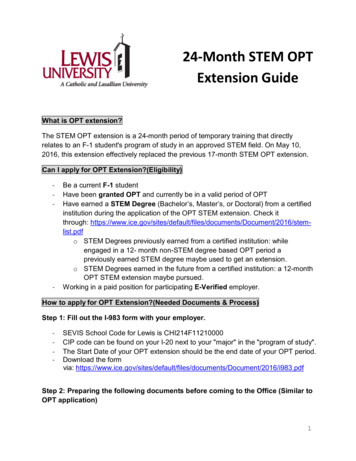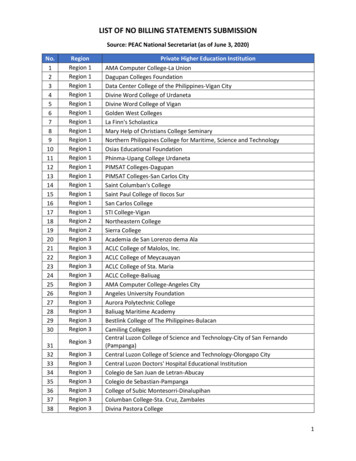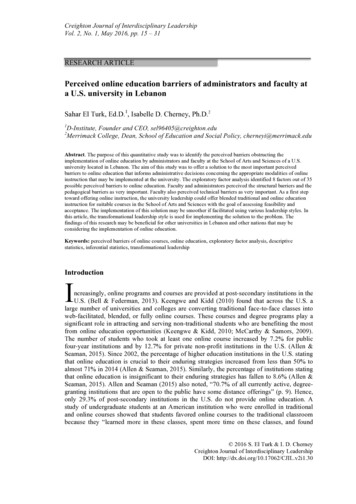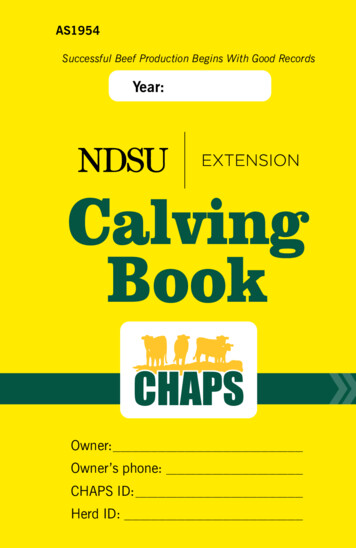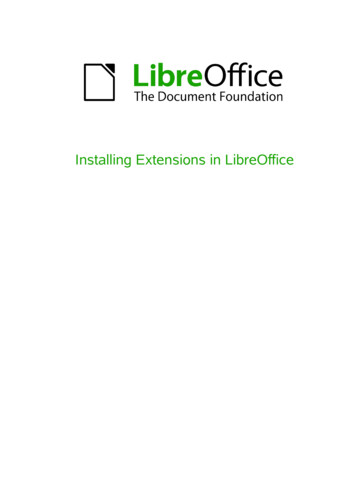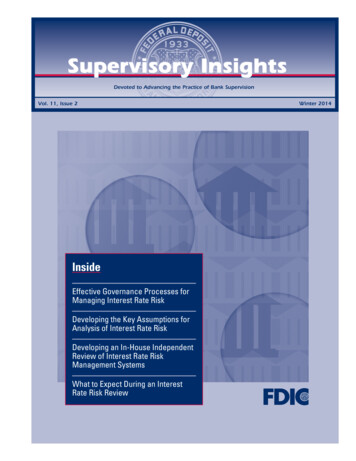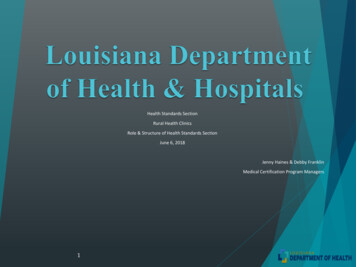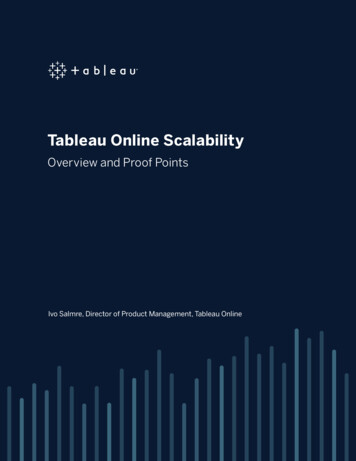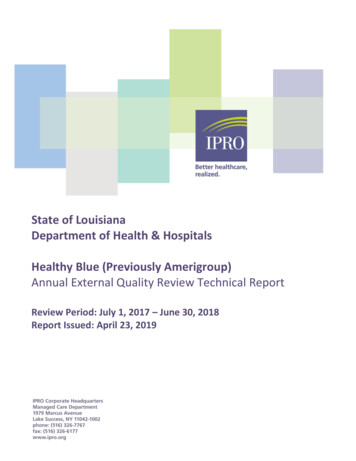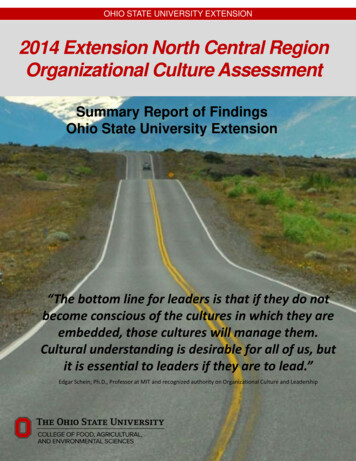
Transcription
OHIO STATE UNIVERSITY EXTENSION2014 Extension North Central RegionOrganizational Culture AssessmentSummary Report of FindingsOhio State University Extension“The bottom line for leaders is that if they do notbecome conscious of the cultures in which they areembedded, those cultures will manage them.Cultural understanding is desirable for all of us, butit is essential to leaders if they are to lead.”Edgar Schein, Ph.D., Professor at MIT and recognized authority on Organizational Culture and Leadership
Page intentionally left blank
Study OverviewIntroductionThis summary presents Ohio results as a part of aregional organizational culture study conducted July2014.Study Overview .What is Organizational Culture?.The Denison Model Moving The Needle Summary of Findings Thoughts to Ponder & Contact Info Appendix A .Appendix B .Pg. 1Pg. 2Pg. 3Pg. 5Pg. 7Pg. 8Pg. 9Pg. 10PopulationThe quantitative study was designed to gainpersonnel perceptions on work related conceptsassociated with organizational culture. The targetpopulation for this study was personnel with 0.25FTE or greater Extension appointments or equivalentresponsibilities as recognized by each individualparticipating state.Participating North Central Region States include:PurposeThe primary purpose of this study was to establish afoundational cultural framework for the NorthCentral Region and participating states that informsorganizational change initiatives through: Predicting organizational response to andreadiness for change, Assessing organizational strengths andweaknesses that are directly impactingorganizational performance, Identifying a level of synergy in organizationalsystems and functions, and Identifying areas of focus where improvementsmay be warranted.MethodsData were collected through a web-basedquestionnaire with an overall response rate of37% across the ten participating states. Ohio hada 41% response rate. See Appendix A for ademographic profile of respondents.Instrumentation was a modified version of theDenison Organization Culture Survey (DOCS). TheDOCS “is designed to assess an organization’sstrengths and weaknesses as they apply toorganizational performance.” Participants wereasked to rate 60 statements referencing fourorganizational traits and 12 managementpractices on a scale of ‘1- strongly disagree’ to ‘5strongly agree.’ Data analysis was conductedthrough Denison Consulting Services and reportedas percentiles against a normed global databaseof organizations.Page 1 of 15Limitations Responses reflect internally held perceptionsof our organization, not external, Responses may reflect viewpoints of subcultures within our organization, and Things beyond our control could haveinfluenced responses. Are responses based onliving in the Extension world or Universityculture? How much influence do we have tocreate change?
OHIO STATE UNIVERSITY EXTENSIONWhy is Organizational Culture Important?An organization’s culture has been shown to directlyinfluence organizational performance and long-termeffectiveness (Cameron & Quinn, 2011). In fact,organizational culture has been deemed critical to anorganization’s ultimate success or failure (Schein,2010).Organizational Culture Defined a collection of shared beliefs,values, meanings, and behaviorsthat a group has adopted over timeas a way to survive and succeed.Comprised as a collection of an organization’sassumptions, values, beliefs, and artifacts,organizational culture serves as a sense of stability forthose within by providing guidelines on how to feel,perceive, and react to various situations (Schein,2010).Three levels of CultureSchein, 2010What weCAN seeArtifactsValues &BeliefsWhat weCAN’T seeUnderlyingAssumptionsOr simply put “the way things aredone around here.”Adapted from Denison Consulting, 2009The culture of an organization exerts varying degreesof influence on overall performance. The mostimportant and likely most challenging influence comesfrom underlying assumptions which are rarelyapparent until directly challenged (Schein, 2010).These assumptions are especially tough to navigatewhen undergoing any organizational change initiatives(Latta, 2009).The bottom line is that if leaders strive to createsustainable change in their organizations they mustbecome conscious of the cultures in which they areembedded or risk that the cultures will ultimatelymanage them (Schein, 2010).Assessing Organizational Culture“Organizationalculture is one ofmany situationalvariables that haveemerged as pivotalin determining thesuccess of leaders’efforts toimplement changeinitiatives”Latta, 2009Based on decades of empirical research, the DOCSinstrument has been designed to assess organizationalstrengths and weaknesses as they directly apply to theperformance of an organization. Particularly theDenison survey and model is structured to revealunderlying beliefs and assumptions in recognizableand measurable ways.The survey contains 60 items measuring specificaspects of an organization’s culture across four traitsand twelve management practices. Analysis is donethrough normative scoring and reported in percentiles.This means that your organization has been comparedto thousands of both under and over performingorganizations worldwide.Page 2 of 15
Denison Model: Traits, Tensions, and Management PracticesAdaptability: translating thedemands of the externalenvironment into action.Includes: Creating Change Customer Focus Organizational LearningExternal FocusAware of the market, able toadapt and change in response.Posses the ability to grow asthey meet current and futureneeds of their stakeholders.Flexiblemeaningful long-termdirection for the organization.Includes: Strategic Direction &Intent Goals & Objectives VisionStableAre able toquickly change inresponse to theirenvironment.Tend to besuccessful atbeing innovativeand satisfyingclientele.Focused andpredictable. Knowwhere they areheaded and havetools and systemsin place to getthere.Consistency: Defining theInvolvement: Buildinghuman capability andcreating a shared sense ofownership and responsibilitythroughout the organization.Includes: Empowerment Team Orientation Capability DevelopmentMission: Defining aInternal FocusFocus is on the alignment ofinternal systems, processes,and people. Typically predictsefficient operatingperformance, high quality,and increased employeesatisfaction.values and systems that arethe basis of culture.Includes: Core Values Agreement Coordination &IntegrationExample: What do we mean by percentile?If your score is 48. This means your organization scored equal to or higherthan 48% of the organizations in the global database.Page 3 of 15
Mission: Defining a meaningful long-term direction for the organization. Strategic Direction & Intent: Do employees understand thestrategies identified by the organization and do they think thestrategies will work? Goals & Objectives: Are there short-term goals that help linkwhat employees do on a day-to-day basis to the strategy andvision of the organization? Do employees understand how theirjob fits in? Vision: Do employees share a common desired future state forthe organization? Do they understand the vision? Does it motivateand excite them?Adaptability: Translating the demands of the external environment into action. Creating Change: Can employees read the externalenvironment and react to trends and changes? Doemployees constantly look for new and improved ways to dotheir work? Customer Focus: Do we understand the needs of ourcustomers? Are employees committed to responding to theirever-changing needs? Is customer focus a primary concernthroughout the organization? Organizational Learning: Is importance placed on learningin the workplace? Do we create an environment wherereasonable risk taking and innovation can occur? Do weshare knowledge across the organization?Involvement: Building human capability and creating a shared sense of ownership andresponsibility throughout the organization. Empowerment: Do employees feel informed and involved inthe work that they do? Do they feel they can have a positiveimpact on the organization? Team Orientation: Is teamwork encouraged AND practicedin the organization? Do employees value collaboration and feelmutually accountable for common goals? Capability Development: Do employees believe that theyare being invested in and that their skills are improving? Isthe organization’s bench strength improving? Does theorganization have the skills it needs to be competitive todayand into the future?Consistency: Defining the values and systems that are the basis of the culture. Core Values: Do employees share a set of values that createa strong sense of identity and a clear set of expectations? Doleaders model and reinforce those values? Agreement: Is the organization able to reach agreement oncritical issues? Can employees reconcile differences in aconstructive way when problems arise? Coordination & Integration: Do employees from differentparts of the organization share a common perspective thatallows them to work effectively across organizational boundaries?Do they work to eliminate ‘silos’ and promote actions that are in the best interest of theorganization as a whole?Page 4 of 15
Movingthe NeedleInterpreting the findingsStart looking at the big picture and work toward thedetails. Here are some steps to get started.Step 1: Identify your ‘big picture’ strengths &challenges.Step 2: Summarize your strengths through examiningyour higher scores.Step 3: Summarize your challenges throughexamining your lower scores.Step 4: Summarize the insights and their potentialimpact on organizational performance.Be mindful to avoid “analysisparalysis!” Spending excessivetime on what the numbersmean cannot bring aboutchange by itself.Strategies for Moving the NeedleFacilitating meaningful conversations within yourorganization will be a pivotal part in moving theneedle of your culture to where you are achievingcurrent and future organizational goals.Numerous change models are available, providing avariety of frameworks for guiding organizationalchange. Which model you select is dependent uponthe needs and preferences of your organization.Below we have outlined some fundamentalelements that are common to most change models. Page 5 of 15Recognize the need for a cultural changeGain an understanding of where you are currentlyAssemble a team that can help lead the changeCollectively identify what your organization’sideal culture looks likeEstablish parameters for the scope of changeneededCommunicate regularly across all levels of theorganization and every point of the changeprocessEmpower those that will be implementing thechangesCelebrate accomplishments and reward thosesupporting the effortsCollectively create a vision of where you need togoUnderstand what successful change looks likeMaintain a mindset toward continuousimprovement
Summary of Findings:Overarching ThemesStrengths Team orientation, Investment in capabilitydevelopment, Encourage direct contact withclientele, Learning as a part of day to day work, Empowerment & involvement ofemployees in making an impact.Challenges & Opportunities Change attempts are met with resistance, Creating change in response to externalenvironment, Improve decision making particularlyregarding difficult issues, Increase capability to drive changethrough greater clientele focus, Providing more clarity aroundmanagement/ leadership expectations, Greater clarity on the organizationalstrategy particularly among short and longterm goals and objectives.Page 6 of 15
Summary of Findings: Individual ItemsIndividual items and scores are listed in Appendix BHighest and Lowest Items Highest 5 – these scores are about employeesmaking an impact, engagement in your work,and learning. Quadrants Involvement &Adaptability Lowest 5 – most from adaptability, particularlyaround relationships and responsiveness toclientele. Compared to other organizations,OSUE is below the 25th percentile in 4 of the 5individual questions listed.While OSUE encouragescontact with clientele, itappears there is anopportunity to better utilizethe interaction in makingorganizational decisions.AdaptabilityInvolvementTwo of the top 5 highest scores are inEmpowerment. The respondents generally believethat OSUE invests in their capability development,are highly involved in their work and can make apositive impact.Decisions being made where the best informationis available, and problems resulting from a lack ofnecessary skills fall below the 50th percentile.While 2 of the top 5 overall scores (Encouragedirect contact with clientele and Learning as animportant objective in the day-to-day work)were found in this Trait, 4 of the 5 lowestscores were also in this Trait.While OSUE encourages contact with theclientele, it appears as if there is an opportunityto utilize the interaction with the clientele tobetter understand clientele needs and applythat to decisions.ConsistencyMissionOverall, the composite has consistent scoresaround the 50th percentile. Respondents feelthere is a “strong” culture and it is easy tocoordinate projects across different parts of OSUE.One of the lowest overall scores was in the area ofagreement on having a clear “right” and “wrong”way to do things.Scores suggest there may be a clear missionthat provides meaning and direction for thework that employees perform.There also appears to be opportunities toensure that the long-term vision and strategiesare clear. Clarity in Strategic Direction andIntent leads to greater clarity in shorter termgoals & objectives, furthering aligningpersonnel around delivery.Dynamic TensionsThe aim is to strike a balance Flexible vs. Stable OSUE tends to be more stablecharacterized by some levels of focus and predictability. While theremay not be a “clear” direction for the future, the internal tools andsystems are in place to get there. A significant opportunity exists forOSUE to become more readily adaptable to the externalenvironment.Internal vs. External OSUE has a stronger internal focus.Organizations like this are focused on aligning people, processes,and systems. Looking to the external environment and beingadaptable to the needs of clientele is a significant opportunity forOSUE.Page 7 of 15
Thoughts to Ponder Considering the findings What was going on in OSUE that would havepotential implications on how individualsresponded to this survey? What aspects of the report help instillconfidence in the future of OSUE? What aspects of the report merits furtherexploration within OSUE? Looking at the High scores and Lowscores what is it about OSUE culture thatputs this here? For high ones, if this needs tostay, what do you need to do to keep thishere?ReferencesCameron, K. S. & Quinn, R. E. (2011). Diagnosingand changing organizational culture (3rd ed.).San Francisco: John Wiley & Sons. What can you, and/or your colleagues do toimprove OSUE organizational culture?Denison Consulting.http://www.denisonconsulting.com/Latta, G. F. (2009). A process model oforganizational change in cultural context (OC3Model): The impact of organizational culture onleading change. Journal of Leadership andOrganizational Studies, 16(1), p. 19-37.Thank you for yourparticipation!Schein, E.H. (2010). Organizational culture andleadership (4th ed.). San Francisco: Wiley.Ohio State University Research Team:Graham R. Cochran, Keith L. Smith, Jeff King, Jessica Bowen, Karen J. ArgabrightOSU Leadership Center & Gist Research -teamDenison Consulting, LLCWork on this research was supportedby Dr. Keith Smith, George R. andGenevieve B. Gist Endowed Chair inExtension Education and Leadership.121 West Washington, Suite 201Ann Arbor, Michigan 48104Phone: (734) 302-4002www.denisonculture.comPage 8 of 15
Appendix ADemographic Profile of Respondents N 311AgeRange#18-292530-393040-495250-5910160-695270 2No response49GenderTotal Years of Service inExtensionJob GroupJob Group#Admin Support(county & state)53Educator109Program Support46CED/Unit head25Administration16Academic Units15No Response47Program Area RepresentationPage 9 of 15
Appendix BPage 10 of 15
Page 11 of 15
Page 12 of 15
Page 13 of 15
Page 14 of 15
Page 15 of 15
Denison Organization Culture Survey (DOCS). The DOCS "is designed to assess an organization's strengths and weaknesses as they apply to organizational performance." Participants were asked to rate 60 statements referencing four organizational traits and 12 management practices on a scale of '1 - strongly disagree' to '5 -
